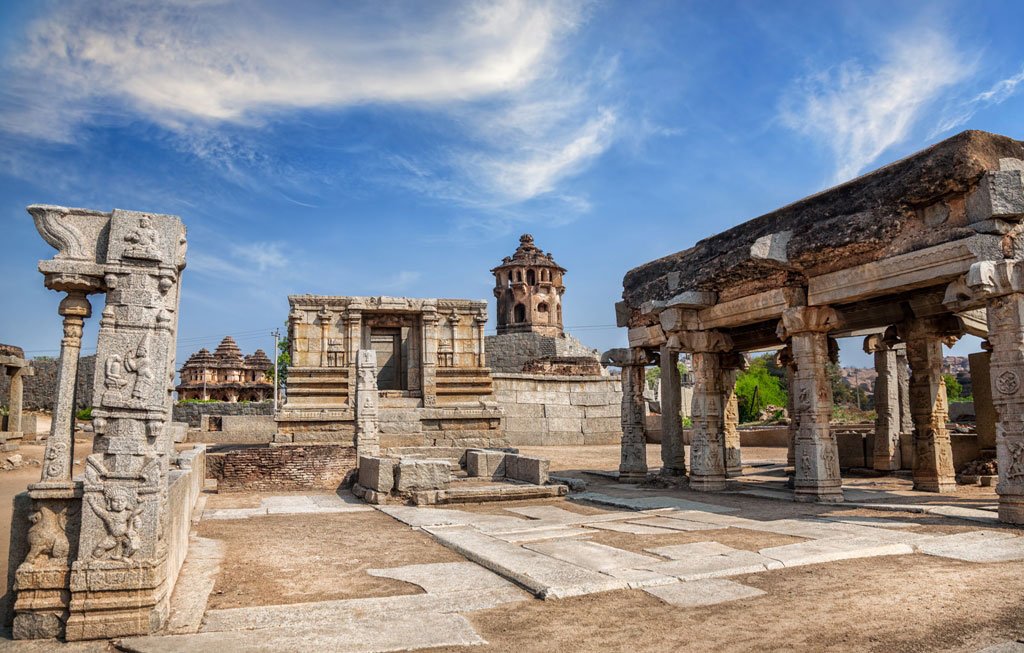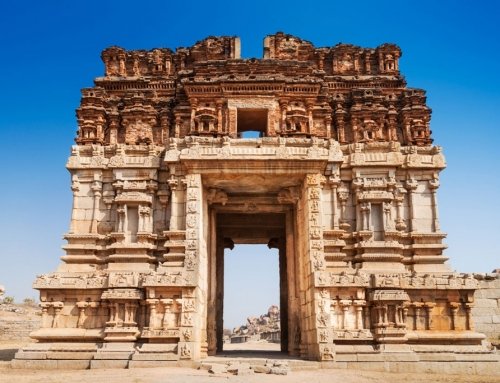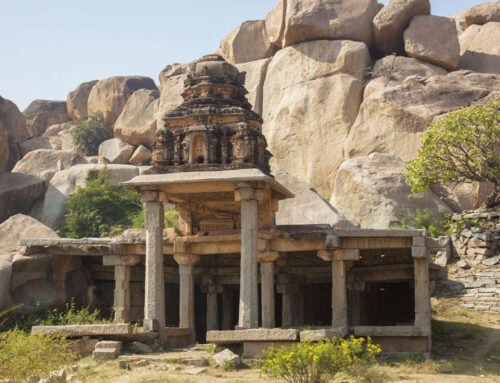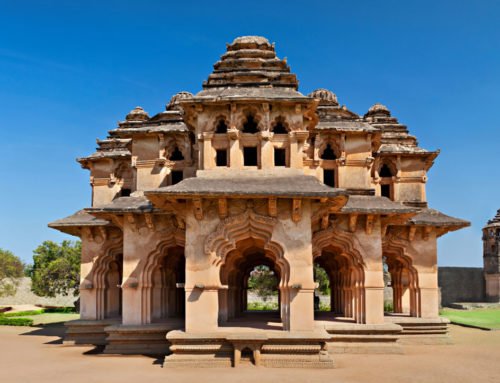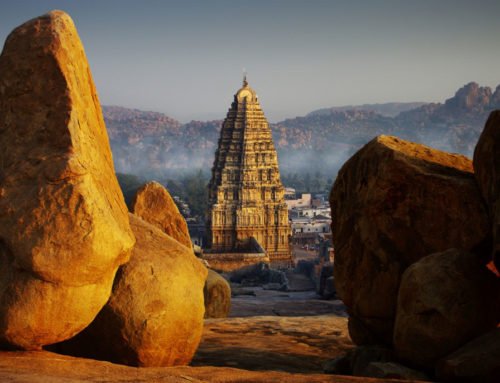Overview
- Main Attractions: Hampi ruins
- Best Time to Visit: Late October to early March
- Local Specialty: Bouldering
- Travelled By: Train, bus
- Cost: $$
- Duration of Stay: 2 days
- Location: Karnataka, India
Author Reviews[display_rating_item_results rating_form_id=”4″ rating_entry_ids=”1″ show_category_filter=”false” show_options=”true” result_type=”star_rating” preserve_max_rating=”true” show_title=”false” show_count=”false” ]
Total Rating: [display_rating_result rating_form_id=”4″ show_count=”false” show_rich_snippets=true] [accordions load=”1″] [accordion title=”User Reviews” last] [display_rating_item_results rating_form_id=”5″ show_options=”true” result_type=”star_rating” preserve_max_rating=”true” show_title=”false” show_count=”true” show_rich_snippets=true] [/accordion] [accordion title=”Add Review”][display_rating_form show_email_input=”true” show_comment_textarea=”true” show_name_input=”true” rating_form_id=”5″] [/accordion] [/accordions]
Summary
Hampi, site of the capital city of the Vijayanagar Hindu empire that rose to conquer the entire south in the 14th century is an extraordinary site of desolate temples, compounds, stables and pleasure baths, surrounded by a stunning boulder-strewn landscape. It has a laid-back vibe that makes any traveller want to stay here for a few more days.
Hampi: Our Experience
28th November 2013 (Day 1)
Our overnight sleeper train arrived from Hyderabad into Hospet early in the morning. We had decided to stay in Hospet rather than Hampi as it was near the train station, restaurants and bus stand.
[singlepic id=4290 w=720 h=560 float=center]
After checking into our hotel and having a nice hot shower, we walked down to the restaurant across the road for a nice South Indian breakfast of idlis and vadas – in keeping with the South Indian tradition.
Idli is a traditional breakfast in South Indian households. Idli is a savoury cake popular throughout the southern part of India. The cakes are made by steaming a batter consisting of fermented black lentils (de-husked) and rice. Most often eaten at breakfast or as a snack, idlis are usually served in pairs with chutney, sambar, or other accompaniments.
Vadas are a savoury fritter-type snack originating from South India. They are shaped in a doughnut or a disc and are between 5 and 8 cm across. They are made from dal, lentil, gram flour or potato. Vadas are preferably eaten freshly fried, while still hot and crunchy and is served with a variety of dips such as sambar and chutney.
Both were really tasty, healthy and filling; however, we did like the vadas more than the idlis as it had more flavour while the idlis were somewhat bland.
[singlepic id=4291 w=720 h=560 float=center]
We also had another dish of puris and sambar just to give our breakfast some variety. The puris were fresh, hot and crispy and the sambar was a great accompaniment to the puris.
We made our way to the main bus stand and took a bus to Hampi only 30 minutes away. The bus stand in Hampi is located at the Hampi Bazaar which is the starting point for excursions into the Hampi ruins.
[singlepic id=4293 w=720 h=560 float=center]
Our first stop was Virupaksha Temple as we were keen to meet Lakshmi, the temple elephant. We were also fortunate to witness a Hindu marriage taking place inside the temple, so we stood around and witnessed the marriage rituals along with a big crowd of onlookers. Then, we head to the back to see Lakshmi being groomed (painted face) and giving blessings in return for a coin.
Located in the centre of Hampi Bazaar, Virupaksha Temple is one of the oldest structures in Hampi. Dedicated to Virupaksha, an incarnation of Shiva, this temple is fully intact among the surrounding ruins.
[singlepic id=4294 w=720 h=560 float=center]
Following a visit to the Virupaksha Temple, we wander up to Matunga Hill, the highest point in the Hampi area to get a bird’s eye view of the entire landscape and, in particular, to see the Hampi Boulders. From this vantage point we could see the entire valley before us which was spectacularly beautiful.
It’s difficult to say what’s more charming in Hampi – whether it’s the amazing architecture or the bizarre looking landscape. Heaps of giant Hampi boulders perch precariously over miles of undulated terrain, their rusty hues off set by jade-green palm groves, banana plantations and paddy fields. A World Heritage Site, Hampi is a place where you can lose yourself among the ruins.
[singlepic id=4295 w=720 h=560 float=center]
As we climbed the boulder-toppled mountain around the ruins of the Vijayanagar Empire we got to see the dizzying scale of the Hindu conquerors’ glory. This site of desolate Hampi Temples, compounds, stables and pleasure baths, surrounded by a stunning boulder-strewn landscape was truly impressive.
[singlepic id=4287 w=720 h=560 float=center]
After walking around all morning, we were tired and hungry so we returned to Hampi Bazaar to find some food. Being a small town, there’s hardly any restaurants except for the ones linked to hostels and guest houses.
Being located on the banks of the Tungabhadra River, Hampi is a lush, fertile valley with a good agricultural economy. The area grows sugarcane and bananas among other crops. As we wandered around the Hampi ruins, we noticed the stacks of bananas being loaded on to trucks.
Given the heat and lack of food available in Hampi Bazaar, we decided to have some bananas with a glass of cold milk for lunch. It was surprising quite a substantial meal.
[singlepic id=4296 w=720 h=560 float=center]
Following lunch, we headed to the Sacred Centre to visit the highlight of the Hampi ruins – Vittala Temple.
Vittala Temple is the undisputed highlight of the Hampi ruins and the grandest of all the religious monuments in the Sacred Centre. Now a World Heritage Monument, this 15th century temple represents the high point of Vijayanagar art and architecture. The centrepiece of this site is a stone chariot with spinning wheels.
By the time we finished at Vittala Temple it was past 4 pm so we made our way to the main bus stand at Hampi Bazaar to catch a bus back to Hospet. Having walked a lot that day, we were quite exhausted so we took a much needed nap in our hotel room.
[singlepic id=4297 w=720 h=560 float=center]
Around 7pm, we headed out in search for a nice place to have dinner in Hospet. Given that most of the restaurants in town catered to South Indian cuisine, we walked a bit out of town to the Muslim district where we found a lovely restaurant catering to Hyderabadi cuisine – Hotel Charminar.
[singlepic id=4292 w=720 h=560 float=center]
On our way back to our hotel, we stop at a local sweet shop, Khamdenu Sweet Shop to try a couple of Indian sweets. We tried a couple of sweets – Rabri and a Coconut laddu. Rabri was clearly our favourite.
Rabri is a famous sweet dish in India made with dahi (yogurt), flour, and a combination of bajre ki roti. Flour of pearl millet (Bajri) is mixed with buttermilk to make a thick sauce which is kept in the sun to ferment. After about 3 to 4 hours, it is cooked by boiling it until the flour is cooked. It may be eaten hot as soup, but it is usually kept overnight and had cold.
The Coconut laddu was made from dessicated coconut and was delicious as well.
[singlepic id=4288 w=720 h=560 float=center]
29th November 2013 (Day 2)
The following morning, we made our way to the main bus depot in Hospet to take a bus to Hampi. Unfortunately, we got there to find out that there was a bus strike so no buses were heading out to Hampi that morning. So we decided to take an auto rickshaw instead. After haggling with the driver for a few minutes who wanted to take us for a tour around Hampi, we found one who was happy to take us to Hampi Bazaar.
[singlepic id=4298 w=720 h=560 float=center]
Today was spent visiting the Royal Centre which is a big part of the Hampi ruins. The Royal Centre contains the buildings, temples and ceremony areas used by the royal members. It includes the famous Lotus Mahal located in the Zenana Enclosure (Women’s Quarters), Elephant Stables as well as the Hazara Rama Temple. There were also the King and Queen’s chambers however most of the buildings had been demolished and only the foundations remained.
Following our visit to the Royal Centre we hiked out way to Kamalapur Village to visit the Archaeological Museum, however, being a Friday it was closed so we had to give the museum a miss. It was late in the afternoon so we caught a bus back to Hospet city.
[singlepic id=4299 w=720 h=560 float=center]
For lunch, we tried Udupi Shree Krishna Bhavan located close to the main bus stand in Hospet. It is famous for its delicious South Indian snacks and thalis. During the day it is a bustling place with locals filling up on the vegetarian thalis and South Indian meals that are on offer at this clean and well-kept establishment.
After lunch we returned to our hotel for a much needed siesta after our long hike around the Hampi ruins.
[singlepic id=4297 w=720 h=560 float=center]
In the evening we returned to Hotel Charminar for another dinner meal at this fantastic Muslim restaurant that specialises in Hyderabadi cuisine. Being a Friday which is a day of prayer and fasting for the Islamic community, we were able to try some of their Friday specials.
After dinner we stopped at our favourite Indian sweet shop, Khamdhenu Sweet Shop for another taste of the popular Indian dessert – rabri.
Our two day-trip to Hampi had come to a quick end and we were sad to be leaving. If we were to return, we would stay in Hampi instead of Hospet and enjoy the laid back ambiance of the ruins and the Tundabhadra River. Hampi had surprised us in so many ways – with its magnificent boulder-strewn landscape, amazing architecture and the chilled vibe that a traveller picks up and wants to cling to for a few more days.
We were sad to see that villages existed among the ruins which were being damaged by the close environment. More has to be done to preserve this unique landscape and architecture. While Global Heritage Fund is trying to classify all of Hampi’s ruins as protected monuments we wish they could speed things up; but knowing Indian bureaucratic red tape we know it’s a tough feat to accomplish.


